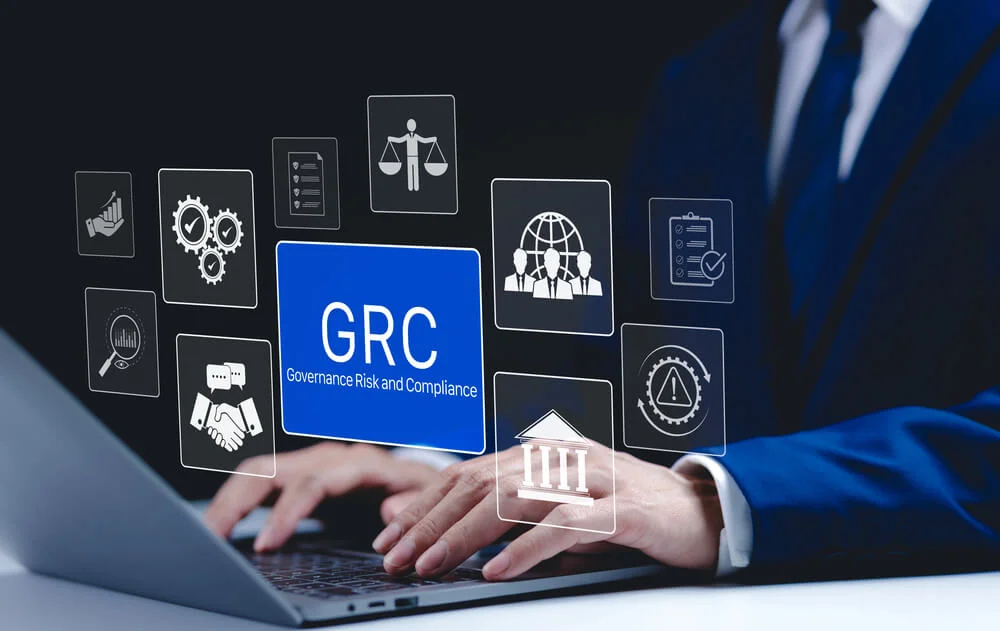After working in management for any amount of time, you’re likely to come across the term “GRC.” If you’ve heard of it, then you’ve probably also gathered that it’s an extremely important process and that most people rely on specialized softwares called GRC tools to navigate it. This begs a few questions, though. What is a GRC tool? For that matter, what is GRC? And most importantly, why do either of them matter? Let’s go over a few of the basics.
What Is a GRC Tool?

If you’re wondering what GRC tools are, you may be surprised to learn that you’ve most likely used one before. They’re an essential tool for any business to run smoothly. In essence, their purpose is to ensure that all business operations follow company standards and legal regulations while minimizing risk.
What Does GRC Stand For?
To fully understand the purpose of a GRC tool, it helps to understand the acronym itself. GRC stands for governance, risk, and compliance, three essential focus points for any modern business. So, what are each of these components, and why are they important?
Governance
Governance is a set of company frameworks, rules, and regulations that ensure smooth and efficient operations. Though they aren’t hard legal standards, they’re no less important to abide by. Ensuring a company’s governance guidelines are followed keeps things running smoothly, and reduces the likelihood of unnecessary risks and compliance issues.
Risk Management
Though the R in GRC technically only stands for risk, it’d be more appropriate to say it stands for risk management. As we’ve written about before, there’s a bit of a difference between risks and active threats to your company. The goal of risk management is to reduce the likelihood that threats will occur. These risk factors can appear anywhere in your business, from finances to cybersecurity.
Using a GRC tool helps you to stay on top of those risks by identifying and correcting them. A high-quality tool can do this semi-autonomously, running scans and drawing attention to risks as needed. Once the risks have been identified, the tool can offer solutions. You can then take these solutions, adjust them as needed, and implement them, stopping threats before they have a chance to start.
Compliance
Compliance is the process of abiding by government rules and regulations for your business. These laws exist to protect you, your employees, and your consumers. Abiding by these regulations keeps your business in good standing with both the law and the general public, thereby increasing your credibility as a brand. Failing to do so will have the opposite effect, as well as some hefty penalties to go along with it. GRC tools are designed to keep you up to date on any changes to government regulations or new compliance standards.
Why Do You Need a GRC Tool?
As you can see, GRC tools are extremely useful. Are they a necessity, though? We certainly believe so. Building a GRC framework without the tools to do so is difficult, and the cost of non-compliance is steep. GRC tools bring substantial benefits. They reduce unnecessary stress, tedious work, and costly mistakes, freeing you up to look at the bigger picture of running a business. Of course, before you can give all of this work to an automated tool, you need to be sure you can trust that tool.
Why Compyl Should Be Your GRC Go-To
As a manager, you want your business and its employees to not just succeed, but go above and beyond. A strong GRC framework is an essential part of this success. To build a framework that lives up to your expectations, though, you need a GRC platform that works just as hard as you do.
Compyl is that platform. We’ve taken care to design it in a way that’s effective, easy to use, and useful for businesses of all types and sizes. Let’s take a quick look at some of the cutting-edge features that make Compyl one of the best governance, risk, and compliance tools on the market.
Simulated Security Incidents
It’s difficult to tell how your business will perform under pressure until a threat is actually presented. Compyl provides a way to do this safely. Once you’ve given your GRC tool the go-ahead, it’ll simulate a cyberattack using similar methods to real hackers. Once the “attack” has concluded, it’ll give you a comprehensive report on which parts of your system work well, which parts don’t, and how you can patch any holes in your security.
Incident Management Tools
While GRC tools like Compyl help reduce the likelihood of a major incident or emergency, it’s impossible to prevent them entirely. You need to work both to prevent an incident and mitigate the damage of any incidents that do occur.
This is where Compyl excels as a platform. Rather than just providing prevention tools, Compyl allows you to get into the thick of the issue. With a host of powerful incident management tools at your disposal, you’ll be able to start doing damage control right away. Once the crisis has been averted, you can figure out what caused the incident and take measures to keep it from happening again.
Scalability

One thing that many businesses fail to account for when deciding on a GRC tool is scalability. If you want to expand your business operations in the future, you need a GRC framework that’ll grow with you. Compyl completely alleviates this concern. Our GRC tool offers three distinct plans: Audit Prep, GRC, and Enterprise, intended for small, medium, and large businesses respectively. Rather than go through the headache of scaling your GRC framework every time your business grows, you can just switch plans, make a few tweaks, and get back to business as usual.
More Information on What a GRC Tool Is
We at Compyl are passionate about providing businesses with GRC solutions that just work, no questions asked. If you’d like to learn more about what a GRC tool is, what it does, and how to use it, feel free to get in touch or book a demo with us today!




